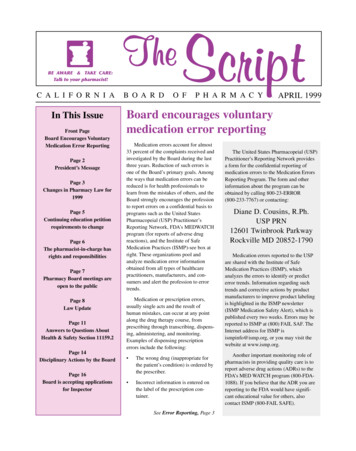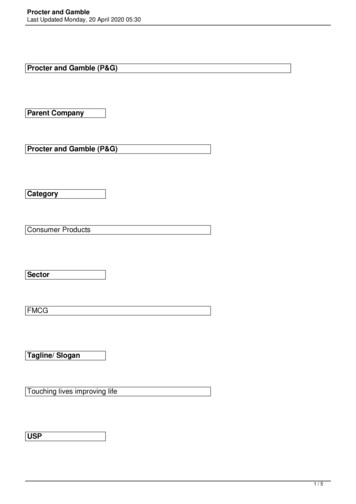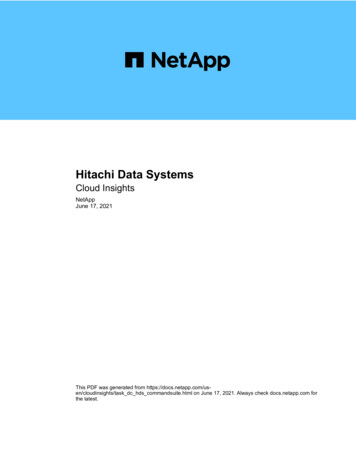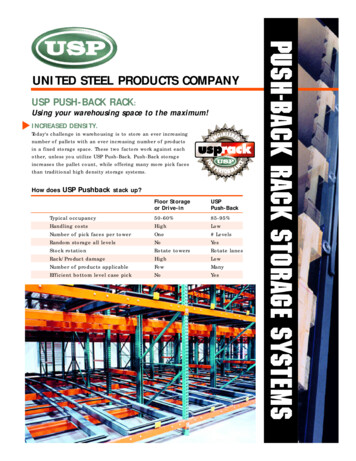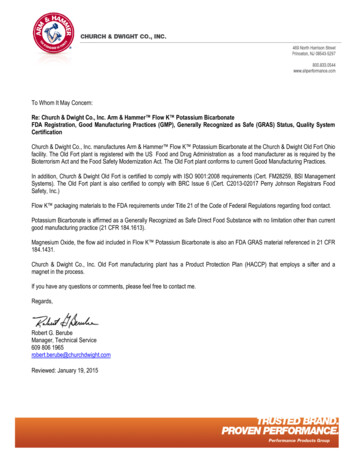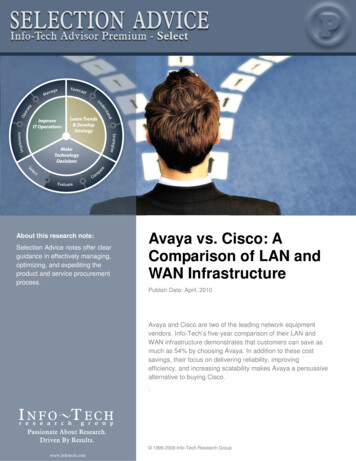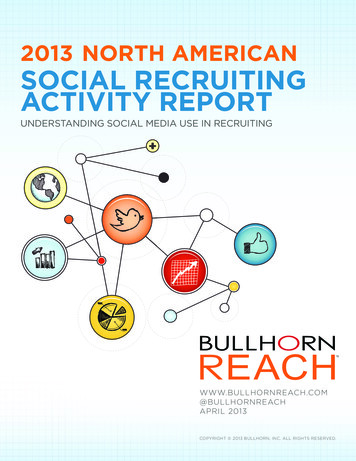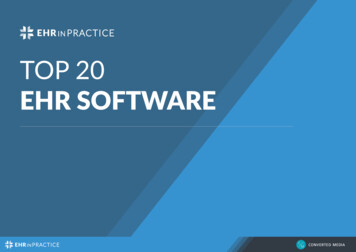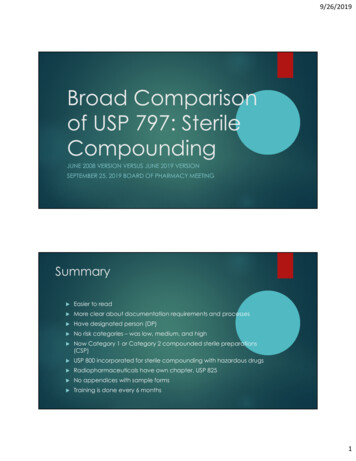
Transcription
9/26/2019Broad Comparisonof USP 797: SterileCompoundingJUNE 2008 VERSION VERSUS JUNE 2019 VERSIONSEPTEMBER 25, 2019 BOARD OF PHARMACY MEETINGSummary Easier to read More clear about documentation requirements and processes Have designated person (DP) No risk categories – was low, medium, and high Now Category 1 or Category 2 compounded sterile preparations(CSP) USP 800 incorporated for sterile compounding with hazardous drugs Radiopharmaceuticals have own chapter, USP 825 No appendices with sample forms Training is done every 6 months1
9/26/2019Summary CAI and CACI in SCA may only be used for Category 1 CSPs 12 hour BUD room temperature or 24 hour BUD refrigerated CAI and CACI in compounding suite may have longer BUDs Pharmaceutical Compounders (PC) in SCA may only be used forCategory 1 CSPs 12 hour BUD room temperature or 24 hour BUD refrigeratedPC in ISO 8 room may have longer BUDs Anteroom not required ISO 8 environment required to have 20 Air Changes Per Hour (ACPH) Sink may be outside ante room in a clean spaceSummary Surface sampling must be done monthly Must attempt to analyze growth to the genus only if out of limits Cleaning and disinfecting more clearly defined Requires use of sporicidal agent monthly Requires Master Formulations, exception CSP for 1 person Requires Compounding Records BUDs changed with some extended but a max regardless of stability Single Dose Vials may be used up to 12 hours as long as storagerequirements are maintained2
9/26/2019Designated Person (DP)June 2008 No mention of designated person(DP) 201 KAR 2:076 Section 3 June 2019 Requires designated person (DP)to oversee USP 797Requires PIC to be knowledgeableand oversee compoundingScope: Types of CompoundedSterile Preparations (CSPs) ClarifiedJune 2008 Irrigations for wounds and bodycavitiesJune 2019 Irrigations for internal body cavities Any space that does not normallycommunicate with theenvironment outside of the bodysuch as the bladder cavity orperitoneal cavity Irrigations for the mouth, rectalcavity, sinus cavity are notrequired to be sterile3
9/26/2019Preparation Per Approved LabelingJune 2008 CSPs include: June 2019 Manufactured sterile products thatare either prepared strictlyaccording to the instructionsappearing in manufacturers'approved labeling (productpackage inserts) or prepareddifferently than published in suchlabeling.Preparing a conventionallymanufactured sterile product inaccordance with the directions inthe manufacturer’s approvedlabeling is out of scope of thischapter only if: The product is prepared as asingle dose for an individualpatient, and The approved labeling includesinformation for the diluent, theresultant strength, the containerclosure system, and storage time.Proprietary Bag and Vial SystemJune 2008 Follow manufacturer’s instructionsfor handling and storing systemsJune 2019 Docking and activation of systemfor immediate administration Docking for future activation andadministration Not considered compoundingIs considered compoundingUse manufacturer beyond usedate (BUD)4
9/26/2019Immediate UseJune 2008June 2019 For emergency or immediateadministration For direct and immediateadministration CSP involves not more than 3different sterile products CSP involves not more than 3different sterile products Compounding is continuous andtakes no more than 1 hour Administration begins within 4hours of start of preparation Administration begins not laterthan 1 hour following the start ofthe preparationCSP CategoriesJune 2008June 2019 Low with 12 hour BUD Low 12 hour BUD room temperature, or Medium 24 hour BUD refrigeratedHigh Compounded in SegregatedCompounding Area (SCA) Category 1Category 2 Have a BUD longer than Category1 CSPs5
9/26/2019TrainingJune 2008 Every 12 monthsJune 2019 Every 12 months: Cleaning Cleaning and disinfecting Didactic exam Calculations, measuring, mixing Use of equipment Documentation of compoundingprocess Principles of HEPA in ISO 5 Proper use of PEC Principles of movement ofmaterials and people Written or electronic examTrainingJune 2008 Low and Medium Risk – 12 monthsJune 2019 Compounding personnel – 6months Hand hygiene and garbing Observed aseptic technique Hand hygiene and garbing Media fill test (MFT) Observed aseptic technique Gloved fingertip test (GFT) Media fill test (MFT Gloved fingertip test (GFT) Initially, 3 times, 0 growth After MFT, up to 3 growthsHigh risk – 6 months Initially, 3 times, 0 growth After MFT, up to 3 growthsSame as above6
9/26/2019Personal HygieneJune 2008 Cannot compound if have:June 2019 Must inform DP if have: Rashes Rashes Oozing sores Oozing sores Conjunctivitis Conjunctivitis Sun burn Recent tattoos Respiratory infection Respiratory infection DP determines if person cancompound and maintain state ofcontrolPersonnel PreparationJune 2008 Must remove: June 2019 Outer garmentsMust remove: Outer garments Cosmetics Hand, wrist, exposed jewelry Cosmetics Hand, wrist, exposed jewelry No ear buds or headphones Nails – neat and trimmed No electronic devices not necessaryfor compounding Wipe eyeglasses, if worn Nails – clean and trimmed No polish, artificial nails, extendersDP may make accommodations ifmaintain state of control7
9/26/2019Hand HygieneJune 2008June 2019 Recommend to not use brush Must not use brushes May use single towels or air dryer Must not use air dryer Remove debris from under nails Use alcohol based, waterlesssurgical scrub with persistentactivityMust use closed system (nonrefillable) soap container Remove visible debris with nailpick Use alcohol based hand rubbefore donning sterile gloves Sterile gloves not donned ordoffed in ISO 5GlovesJune 2008June 2019 Not specifically stated to donsterile gloves over isolator gloves States sterile gloves must bedonned over isolator gloves Apply sIPA 70% each time leaveISO 5 Apply sIPA 70%: Regularly When touch nonsterile surface8
9/26/2019Types of Secondary EngineeringControls (SECs) and DesignJune 2008June 2019 Allows for HEPA filters upstream Must have line of demarcation(LOD) in ante roomHEPA filters must be in ceiling ofbuffer and ante rooms Must have LOD in ante room ORhave clean and dirty ante roomsTypes of Primary EngineeringControls (PECs) and PlacementJune 2008 No mention of Integrated VerticalLaminar Flow Zone (IVLFZ)June 2019 Laminar Airflow Work Bench(LAWF) Integrated Vertical Laminar FlowZone (IVLFZ) Per USP 795 – it is difficult toachieve and maintainunidirectional airflow in IVLFZsBiological Safety Cabinet (BSC)9
9/26/2019Types of Primary EngineeringControls (PECs) and PlacementJune 2008 Compounding Aseptic Isolator(CAI) and Compounding AsepticContainment Isolator (CACI) June 2019 May be in non-classified area forall types of compoundingRestricted-Access Barrier System(RABS) Compounding Aseptic Isolator(CAI) Compounding AsepticContainment Isolator (CACI) For Category 1 – may be in SCA For Category 2 – must be in cleanroom suite with buffer and anteroomsTypes of Primary EngineeringControls (PECs) and PlacementJune 2008 Pharmaceutical Compounder(PC) – not addressedJune 2019 Pharmaceutical Compounders(PC) For Category 1 – may be in SCA For Category 2 – must be in ISO 8environment Do not need ante room10
9/26/2019Air Exchange Requirements (ACPH)June 2008 Recommended ISO 8environments have 20 ACPHJune 2019 Required ISO 8 environments have20 ACPH At least 15 ACPH must come fromthe HEPA filters in ceilingWater SourcesJune 2008 Sink must be on clean side of anteroomJune 2019 Allows sink to be inside or outsideof ante room If outside ante room, must be in aclean space11
9/26/2019CertificationJune 2008 Certification report not required torecord number of people in eachPEC and SEC during particlecounts and smoke testingJune 2019 Certification must record numberof people in each PEC and SECduring particle counts and smoketestingEnvironmental MonitoringJune 2008 Silent on time of taking viable airsampling and surface samplingJune 2019 Viable air sampling must beconducted under dynamicconditions Surface sampling must beperformed at end ofcompounding activity before areahas been cleaned12
9/26/2019Viable Air SamplingJune 2008June 2019 Fungal sampling required for highrisk compounding only Fungal sampling required for allcompounding May sample 400 to 1000 L of air Must sample 1000 L of air at alllocations Must attempt to analyze growthdown to genus if exceed actionlevels Exception: ISO 5 must be 1000 LMust analyze all growth down tothe genusSurface SamplingJune 2008 Surface sampling performedperiodically Surface sampling performedmonthlyTypically every 6 months Performed at the end ofcompounding prior to cleaning Must attempt to analyze growthdown to genus if exceed actionlevels June 2019Must analyze all growth down tothe genus13
9/26/2019Cleaning and DisinfectingJune 2008 Cleaning and disinfecting usedinterchangeably Sporicidal agent not requiredJune 2019 Defines cleaning and disinfecting Requires use of sporicidal agentmonthlyIntroducing Items into the SEC andPECJune 2008 Allows items to be sprayed orwiped prior to introduction intoclean side of ante room Allows items to be sprayed orwiped prior to introduction into thePECJune 2019 Requires items to be wiped withlow lint wiper by a gloved personprior to introduction into clean sideof ante room Requires items to be wiped withlow lint wiper prior to introductioninto PEC14
9/26/2019Component SelectionJune 2008 Allows for more discretion inobtaining APIsJune 2019 Active Pharmaceutical Ingredients(APIs) Must be from FDA registeredfacilityOther Components Should be from FDA registeredfacilityComponent StorageJune 2008June 2019 Must monitor temperature ofcomponent storage area Must monitor temperature ofcomponent storage area Must monitor humidity ofcomponent storage area Humidity not required to bemonitored in component storagearea15
9/26/2019SterilizationJune 2008 CSPs not sterilized within 12 hoursat cold temperature or 6 hoursroom temperature must be sterilitytestedJune 2019 Injectables must be sterilized within6 hours of completing preparation For filter sterilization, cannot usefilters labeled, “For Laboratory UseOnly”DepyrogenationJune 2008 Endotoxin Challenge Vials (ECV)must be use – frequency notdefinedJune 2019 Endotoxin Challenge Vials (ECV)must be used annually16
9/26/2019Master FormulationJune 2008 Master Formulation (MF) notspecifically addressedJune 2019 Master Formulation required forCSPs for more than 1 patient orinvolving nonsterile ingredientsMaster Formulation Requirements Name, strength or activity, and dosage form of the CSP Identities and amounts of all ingredients Type and size of container–closure system(s) Complete instructions for preparing the CSP, including equipment, supplies, adescription of the compounding steps, and any special precautions Physical description of the final CSP BUD and storage requirements Reference source to support the stability of the CSP Quality control (QC) procedures (e.g., pH testing, filter integrity testing) Other information as needed to describe the compounding process and ensurerepeatability (e.g., adjusting pH and tonicity, sterilization method (e.g., steam,dry heat, irradiation, or filter)17
9/26/2019Compounding Records (CR)June 2008 Compound Records (CR) vaguelyaddressedJune 2019 Compound Records (CR) requiredfor all CSPsCompounding Records Requirements Name, strength or activity, and dosage form of the CSP Date and time of preparation of the CSP Assigned internal identification number (e.g., prescription, order, or lot number) A method to identify the individuals involved in the compounding process andverifying the final CSP Name of each component Vendor, lot number, and expiration date for each component for CSPs prepared formore than 1 patient and for CSPs prepared from nonsterile ingredient(s) Weight or volume of each component Strength or activity of each component Total quantity compounded Assigned BUD and storage requirements Results of QC procedures (e.g., visual inspection, filter integrity testing, pH testing) Master Formulation Record reference for the CSP, if applicable Calculations made to determine and verify quantities and/or concentrations ofcomponents, if applicable18
9/26/2019Visual Inspection of CSPJune 2008 Must use light and darkbackground to visually check CSPJune 2019 Must visually check CSPSterility Testing NumbersJune 2008 Must follow USP 71 for quantities tobe sterility tested Minimum to send for sterility testingis 4June 2019 For quantities of 40 CSPs or more,must follow USP 71 for quantities tobe sterility tested For quantities of 1 to 39 CSPs, test10% rounded up to nearest wholenumber19
9/26/2019Bacterial Endotoxin TestingJune 2008 Required for high risk CSPscompounded in groups of morethan 25 single dose packages or inmultiple dose packages used formultiple patientsJune 2019 Category 2 CSPs compoundedfrom nonsterile components with aBUD requiring sterility testing MUSTbe endotoxin tested Category 2 CSPs compoundedfrom nonsterile components with aBUD not requiring sterility testingSHOULD be endotoxin testedLabelingJune 2008 Labeling and label not definedJune 2019 Labeling – all labels and otherwritten, printed, graphic matter onimmediate container or, on or in,any package wrapper in whichCNSP is enclosed Label – the part of the labeling onthe immediate container20
9/26/2019Beyond Use Date (BUD): Definitionsfrom June 2019 Version Aseptic processing Compounding with only sterile ingredients, or Compounding with nonsterile ingredients, followed by sterilization byfiltration Note: sterilization by filtration is not a form of terminal sterilizationTerminal sterilization Compounding with sterile and/or nonsterile starting ingredients andsubsequent sterilization with a process to achieve a Probability of aNonsterile Unit (PNSU) of 10-6 Examples: dry heat sterilization, steam sterilization, irradiationBUDsJune 2008 Low Risk in SegregatedCompounding Area (SCA) 12 hoursJune 2019 Category 1 Compounded in SCA 12 hours room temperature 24 hours refrigerated21
9/26/2019BUDsJune 2008 Low Risk – no sterility testingJune 2019 Category 2 48 hours room temperature Aseptically compounded 14 days refrigerated No sterility testing 45 days frozen All sterile ingredientsMedium Risk – no sterility testing 4 days room temperature 30 hours room temperature 10 days refrigerated 9 days refrigerated 45 days frozen 45 days frozenBUDsJune 2008 June 2019High Risk – no sterility testing Category 2 24 hours room temperature Aseptically compounded 3 days refrigerated No sterility testing 45 days frozen Nonsterile components 1 day room temperature 4 days refrigerated 45 days frozen22
9/26/2019BUDsJune 2008June 2019 Low, Medium, High Risk Category 2 Sterility tested Aseptically Compounded BUD is limited by stability of CSP Sterility tested Sterile and/or nonsterile startingingredients 30 days room temperature 45 days refrigerated 60 days frozenBUDsJune 2008 June 2019High Risk – no sterility testing Category 2 24 hours room temperature Terminally sterilized 3 days refrigerated No sterility testing 45 days frozen 14 days room temperature 28 days refrigerated 45 days frozen23
9/26/2019BUDsJune 2008June 2019 High Risk Category 2 Sterility tested Terminally Sterilized BUD is limited by stability of CSP Sterility tested 45 days room temperature 60 refrigerated 90 frozenCompounded Multiple Dose VialsJune 2008 Silent on antimicrobialeffectiveness testingJune 2019 Must perform antimicrobialeffectiveness testing May perform testing, requiredonce May rely on data from FDAregistered facility May rely on data from peer reviewliterature May bracket test using lowest andhighest concentrations24
9/26/2019Single Dose Vials (SDV)June 2008June 2010 SDV punctured in ISO 5 SDV punctured in ISO 5 Stored in ISO 5 May be used up to 6 hoursMay be used up to 12 hours aslong as storage requirements aremaintainedPharmacy Bulk PackagingJune 2008 Pharmacy Bulk Packaging treatedlike a single dose vial Stored in ISO 5 up to 6 hours, thendiscardedJune 2019 Pharmacy Bulk Packaging must beused per manufacturer’s labeling25
9/26/2019Use of Compounded Single DoseCSPs and Stock Solution CSPsJune 2008 Not clearly addressedJune 2019 When compounded single dose (SD)CSPs or stock solution (SS) CSPs areused to compound additional CSPs Original SD or SS CSPs must beentered/punctured in ISO 5 or better Must be stored under conditionsupon which BUD is based SD or SS CSP may be used up to 12hours or its BUD, whichever is shorter Reminder discarded Room temperature, refrigeratedStandard Operating Procedures(SOPs)June 2008 Does not address the frequency ofreview of SOPsJune 2019 SOPs must be reviewed every 12months and documented review26
9/26/2019Quality Assurance and QualityControlJune 2008 Has a Quality AssurancerequirementJune 2019 Quality Assurance (QA) System of procedures, activitiesand oversight that ensures thecompounding process consistentlymeets quality standardsQuality Control (QC) Sampling, testing anddocumentation of results that,taken together, ensure thatspecifications have been metbefore releasing the CNSPComplaint Handling and AdverseEventsJune 2008 Complaint Handling and AdverseEvents are not specificallyaddressedJune 2019 DP must review all complaints If quality issue, must investigateand have corrective action Must keep readily retrievablerecord of all complaints, include Name of complaint (or some ID) Date complaint received Nature of complaint Response to complaint Findings of any investigation Follow-up27
9/26/2019Compounding Allergenic ExtractsJune 2008 Allergen Extracts as CSPs Section Exempts Allergen CSPs frompersonnel, environmental, andstorage requirements of Chapter ifcertain criteria are metJune 2019 Compounding Allergenic ExtractsSection Not Category 1 or 2 CSPs Requirements for: Personnel qualifications Hand hygiene and garbing Facilities Cleaning and disinfecting BUDs – up to 1 year Labeling Shipping and transporting Documentation including CRUSP 797 June 2019 version - expected compliance Federally has beendelayed to an unknown time Previously was December 1, 2019201 KAR 2:076 specifically references the June 1, 2008 version of USP797 Waivers are allowed Waiver granted for inhalation being a clean preparation but not sterile Waiver granted to follow SDV Waiver to nuclear pharmacy to open syringes outside ISO 528
9/26/2019 2 Summary CAI and CACI in SCA may only be used for Category 1 CSPs 12 hour BUD room temperature or 24 hour BUD refrigerated CAI and CACI in compounding suite may have longer BUDs Pharmaceutical Compounders (PC) in SCA may only be used for Category 1 CSPs 12 hour BUD room temperature or 24 h

